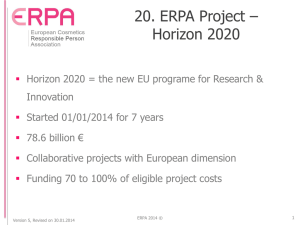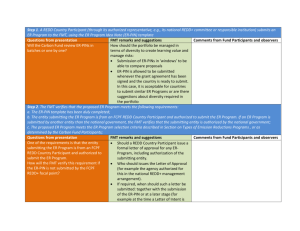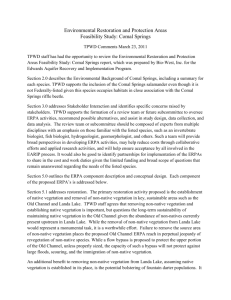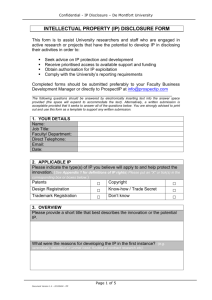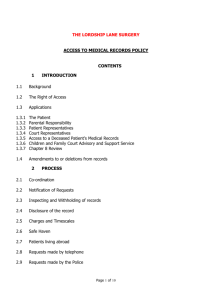October 29, 2014 Dear Members of the FCPF Participants
advertisement
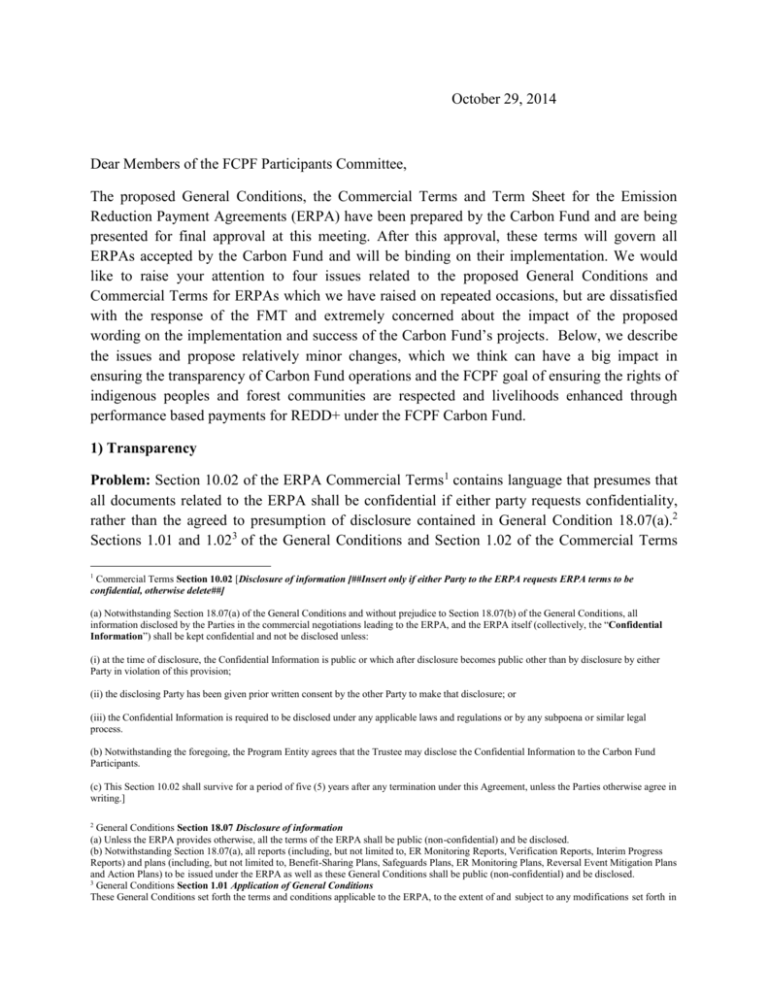
October 29, 2014 Dear Members of the FCPF Participants Committee, The proposed General Conditions, the Commercial Terms and Term Sheet for the Emission Reduction Payment Agreements (ERPA) have been prepared by the Carbon Fund and are being presented for final approval at this meeting. After this approval, these terms will govern all ERPAs accepted by the Carbon Fund and will be binding on their implementation. We would like to raise your attention to four issues related to the proposed General Conditions and Commercial Terms for ERPAs which we have raised on repeated occasions, but are dissatisfied with the response of the FMT and extremely concerned about the impact of the proposed wording on the implementation and success of the Carbon Fund’s projects. Below, we describe the issues and propose relatively minor changes, which we think can have a big impact in ensuring the transparency of Carbon Fund operations and the FCPF goal of ensuring the rights of indigenous peoples and forest communities are respected and livelihoods enhanced through performance based payments for REDD+ under the FCPF Carbon Fund. 1) Transparency Problem: Section 10.02 of the ERPA Commercial Terms1 contains language that presumes that all documents related to the ERPA shall be confidential if either party requests confidentiality, rather than the agreed to presumption of disclosure contained in General Condition 18.07(a).2 Sections 1.01 and 1.023 of the General Conditions and Section 1.02 of the Commercial Terms 1 Commercial Terms Section 10.02 [Disclosure of information [##Insert only if either Party to the ERPA requests ERPA terms to be confidential, otherwise delete##] (a) Notwithstanding Section 18.07(a) of the General Conditions and without prejudice to Section 18.07(b) of the General Conditions, all information disclosed by the Parties in the commercial negotiations leading to the ERPA, and the ERPA itself (collectively, the “Confidential Information”) shall be kept confidential and not be disclosed unless: (i) at the time of disclosure, the Confidential Information is public or which after disclosure becomes public other than by disclosure by either Party in violation of this provision; (ii) the disclosing Party has been given prior written consent by the other Party to make that disclosure; or (iii) the Confidential Information is required to be disclosed under any applicable laws and regulations or by any subpoena or similar legal process. (b) Notwithstanding the foregoing, the Program Entity agrees that the Trustee may disclose the Confidential Information to the Carbon Fund Participants. (c) This Section 10.02 shall survive for a period of five (5) years after any termination under this Agreement, unless the Parties otherwise agree in writing.] 2 General Conditions Section 18.07 Disclosure of information (a) Unless the ERPA provides otherwise, all the terms of the ERPA shall be public (non-confidential) and be disclosed. (b) Notwithstanding Section 18.07(a), all reports (including, but not limited to, ER Monitoring Reports, Verification Reports, Interim Progress Reports) and plans (including, but not limited to, Benefit-Sharing Plans, Safeguards Plans, ER Monitoring Plans, Reversal Event Mitigation Plans and Action Plans) to be issued under the ERPA as well as these General Conditions shall be public (non-confidential) and be disclosed. 3 General Conditions Section 1.01 Application of General Conditions These General Conditions set forth the terms and conditions applicable to the ERPA, to the extent of and subject to any modifications set forth in make clear that if incorporated into an ERPA, the confidentiality provisions of Section 10.02 of the Commercial Terms trump the disclosure provisions of 18.07(a). This contractual framework sends the wrong signal to ER Program proponents about the critical importance of having the draft commercial terms of ERPA, the ERPA itself, and all of the related safeguard, benefit sharing and monitoring arrangements, and monitoring and verification reports in the public domain during the time the program is being designed, when participating/affected stakeholders are being consulted, as well as during the implementation of the ER Program. Solution: This can be solved by changing the language of Section 10.02 of the Commercial Terms as follows: Consistent with Section 18.07 (a) and (b) of the General Conditions, all information disclosed by the parties in the commercial negotiation leading to the ERPA, and the ERPA itself, will be made public, unless at the time of disclosure the ER Program Proponent has presented a well-reasoned rationale for non-disclosure and this reason has been accepted by the Trustee as consistent with World Bank’s Access to Information Policy (“Confidential Information”). Any Confidential Information accepted by the Trustee shall be kept confidential and not be disclosed unless: [Same as existing Section 10.02 of the Commercial Terms] 2) Submission of safeguard plans with the broad community support and/or free prior informed consent of affected communities Problem: Disclosure of the final safeguards plan and the benefit sharing plans with affected communities are prerequisites for the effective negotiation of ERPA’s. In the Methodological Framework, those plans are required to be developed in consultation with affected communities. In the General Conditions they can be delayed until the project proponent wants to sell their emissions reductions credits (ERs) to the Carbon Fund. In many cases preparation of these plans will require broad community support and/or free prior informed consent. Such consultation and negotiation requires that the plans are disclosed to affected/participating communities in languages and forms understandable to them, and at an early stage of ER Program design. Additionally any sub-project agreements, arrangements or similar, which may involve transfer of rights to carbon from communities/owners of land/forest to ER Program entities, to be understood and negotiated in good faith, require a clear understanding of the safeguard and benefit sharing arrangements, and the monitoring and recourse mechanisms included in them. However, Footnotes 1 and 3 of the Commercial Terms (page 14) allow the preparation of these documents to be delayed until up to the time of sale of the Emissions Reductions Credits. Delaying the final version of these plans until ERPA signature, or worse after the ERPA is the ERPA. General Conditions Section 1.02 Inconsistency with ERPA If any provision of the ERPA is inconsistent with a provision of these General Conditions, the provision of the ERPA shall govern to the extent of the inconsistency. Commercial Terms Section 1.02 Inconsistency with General Conditions If any provision of this Agreement is inconsistent with a provision of the General Conditions, the provision of this Agreement shall prevail to the extent of such inconsistency. signed and the project is already being implemented or making them conditions of effectiveness will be highly detrimental to indigenous peoples and forest dependant communities unless the indigenous people and forest dependant people and other stakeholders affected by the ER Program have been actively consulted about these plans prior to the signing of the ERPA and during the negotiations and drafting of these plans. While some delay beyond signing the ERPA may be possibly necessary in some very limited cases, such a delay should be a clear last resort measure and in and of itself should raise red flags about the quality and inclusiveness of the ER Program design phase and stakeholder engagement process. Solutions: In Schedule 1 of the ERPA Commercial Terms, Footnote 1 (p.14) should be amended as follows to ensure consistency with the Disclosure Guidance for the CF: In any case, advanced draft versions of such benefit sharing plans, together with documentation that the stakeholder engagement process has been carried out in accordance with the Methodological Framework, acceptable to the IBRD, are required before appraisal begins and final plans before ERPA signature. In Schedule 1 of the ERPA Commercial Terms, Footnote 3 (p.14) should be amended as follows to ensure consistency with the Disclosure Guidance for the CF: In any case, advanced draft versions of such safeguard plans, together with documentation that the stakeholder engagement process has been carried out in accordance with the Methodological Framework and any stakeholder engagement process specific to the ER Program at issue, acceptable to the IBRD, are required at the time of appraisal and final plans no later than sixty days (in case of category A projects) or 30 days (in case of category B projects) before ERPA signing. 3) Title to Carbon Rights under Carbon Fund Funded Programs Problem: Title to Carbon Rights and therefore, legal and beneficial title to Contract Emissions Reductions is a highly complex and problematic area for which insufficient analytical and legal work has been undertaken by the FMT. By requiring ER Program proponents to ensure the ability to transfer title to ER’s “free of any interest, encumbrance or claim of a third-party other than in accordance with the ERPA,” while leaving the determination of title to Carbon Rights without any guidance to the project proponents, the Carbon Fund is incentivizing a rush to nationalize or otherwise assign carbon rights when there may be insufficient development of a national legal framework to clarify these rights or where awareness and good faith negotiations between the ER Program Proponent and affected stakeholders on these issues has not occurred. As the title to carbon rights, and the transfer of those rights to the Carbon Fund, impacts the fundamental rights of people to their lands and forests, this issue needs to be approached with greater caution and with greater remedies for potentially affected peoples and other stakeholders (e.g., communities, specific defined groups of indigenous people). The relevant safeguards policy framework at the World Bank, and the involuntary resettlement policy (OP 4.12) were not designed to include this new category for rights to carbon and have serious limitations in how well they cover scenarios likely in the implementation of a Carbon Fund REDD+ project. The Involuntary Resettlement Policy does, however, cover restrictions on access to forests and therefore the Resettlement Action Plan and/or Resettlement Framework would be the appropriate safeguard instrument to cover any potential restrictions on access to or use of timber or nontimber resources that result from the implementation of ER Programs. Other World Bank safeguards will likely come into play depending on how specific project proponents decide to construct their benefit sharing programs, e.g., if individuals are not eligible to participate or different ethnic groups are given different rights under the benefit sharing programs. Solutions: The relevant sections of the ERPA term sheet should make reference to the Resettlement Action Plan/Resettlement Framework and other relevant World Bank Safeguards and the provisions therein and International Rules. The definition of “Resettlement Plan” (p.13) should be re-formulated to explicitly include restrictions on access to or use of forest resources in accordance with OP 4.12. Section 15.01 should be amended to say: The Program Entity shall ensure throughout the Term that the Program Entity has the ability to transfer Title to ER’s to the Trustee, free of any interest, Encumbrance or claim of a Third Party other than in accordance with the ERPA, the benefit sharing plan and the resettlement action plan consistent with World Bank Operational Policies and International Rules. The footnote #4 in the Schedule 1 Commercial Terms (p.14), which allows for a reduction of the contacted ER’s as a result of failure to demonstrate the ability to transfer title, which could incentivize coercive negotiations by the project proponent, e.g. stakeholders can be threatened with exclusion from the program if the terms offered by the project proponent are not accepted. This provision should be amended to add the following provision at the end of the footnote: If there is a dispute about legal and/or beneficial title to any of the Contract ERs the project proponent shall engage in good faith and transparent negotiations to resolve the dispute, including in all available dispute resolution procedures. Section 15.01(b) of the General Conditions (p.33) appropriately mentions the use of the required a grievance redress mechanism, but should be amended to include mention of the World Bank’s Inspection Panel as a potential means of redress for affected communities. One of the main purposes of the FCPF Carbon Fund is to pilot benefit sharing programs in the context of REDD+. Therefore, no benefit-sharing program in a CF funded ER Program should not meet the goals of Section 6.03 of the General Condition to share a “significant part of the Monetary and Non-Monetary Benefits achieved in connection with the implementation of the ER Program (including received payments for transferred Contract ERs and Additional ERs and Advance Payments) with relevant stakeholders.” Benefit Sharing Programs should be reviewed to ensure that relevant stakeholders have not been excluded from sharing in the benefits of the ER Program and that the benefits being shared constitute “a significant part of the Monetary and Non-Monetary Benefits achieved”, and rejected if they are found not to achieve these goals. 4) Non-Carbon Benefits The definition of Non-Carbon Benefits (NCBs) in the Commercial Terms is as follows: any benefits produced by or in relation to the implementation and operation of the ER Program, other than ERs and Monetary and Non-Monetary Benefits, as specified in the ER Program Document, and, as relevant, any Safeguards Plans. This definition appears to exclude almost all benefits usually included in the definition of NCBs including but not limited to payments for environmental services, ecosystem services, and the like. NCBs should be closely considered in relation to how the Cancun safeguards on REDD+ are being addressed and reported. REDD+ implementation should not only focus on reducing emissions from forest degradation and deforestation but the implementation of conservation, sustainable management of forests and enhancement of forest carbon stocks. Programmatic Element 6 from the Recommendations of the Working Group on the Methodological and Pricing Approach for the Carbon Fund of the FCPF, June 11, 2012, Revised Final Draft: Non-carbon Benefits states as follows: The ER Program contributes to broader sustainable development. This could include, but is not limited to, improving local livelihoods, building transparent and effective forest governance structures, making progress on securing land tenure and enhancing or maintaining biodiversity and/or other ecosystem services. The ER Program should monitor and report on these noncarbon benefits as feasible, taking note of existing and emerging guidance on monitoring of noncarbon benefits by the UNFCCC, CBD, and other relevant platforms. Rationale: • ER Programs inherently provide social and environmental benefits beyond carbon and the mitigation of social and environmental risks. • ER Programs are encouraged to further enhance non-carbon benefits, to contribute to broader sustainable development; and to measure non-carbon benefits in simple and cost-effective ways where feasible. Virtually all of the NCBs listed in Element 6 are excluded from the definition of NCBs included in the General Conditions. The definition in the General Conditions needs to be amended to be consistent with the Guidelines. This is particularly important for REDD+ countries as NCBs can be an element of discussion in the pricing discussions as set forth in the Guidelines and adopted by the PC in Resolution PC/12/2012/3. The definition of NCBs should list the NCBs not itemize what are not NCBs to the point that the ER Programs have virtually no NCBs which is contrary to the spirit of REDD+. We look forward to discussing these issues and the General Conditions and the Commercial Terms in at the upcoming meeting of the PC in Arusha, Tanzania. Very truly yours, Bank Information Center Environmental Investigation Agency Rainforest Foundation Norway
